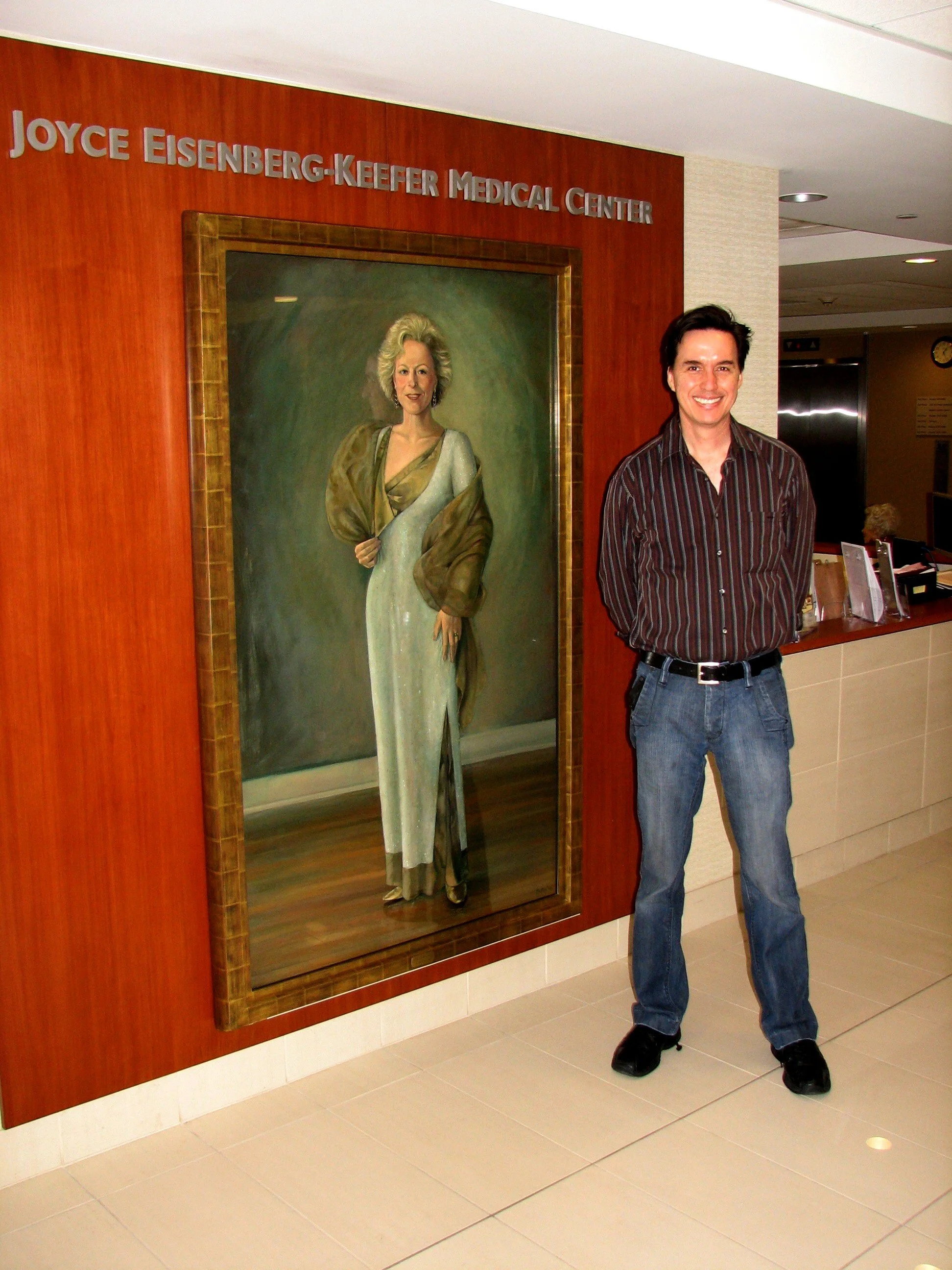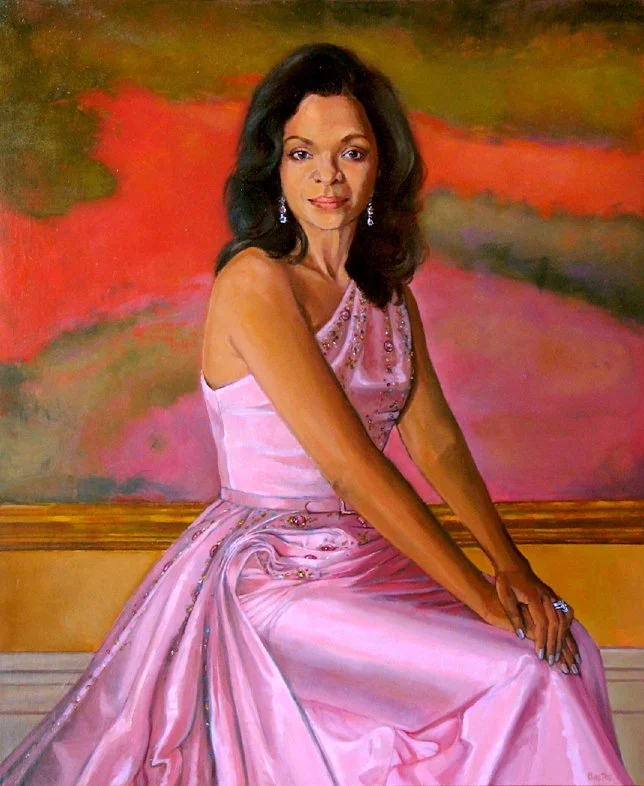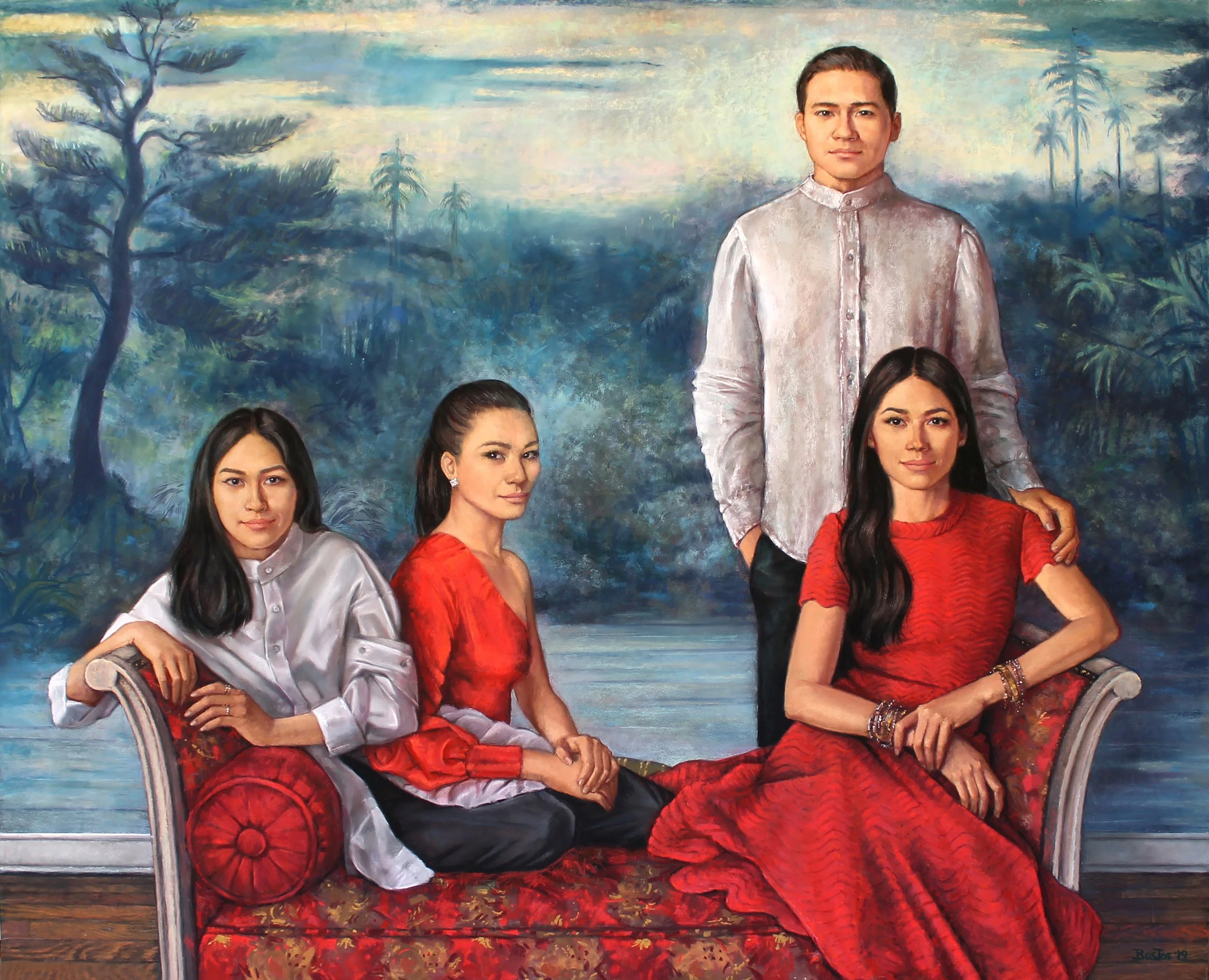Juan F. Bastos: Capturing Beauty and Strength in Portraits
BY MONICA LOFSTROM
EGW GLOBAL MAGAZINE Summer 2023
We had the extraordinary privilege of sitting down with the remarkable portrait painter Juan F. Bastos for an exclusive interview. Spending time with Juan is an experience that words can hardly capture—his infectious happiness and profound passion for the women he has painted radiate from his very being. His dapper and handsome style is a reflection of his artistic prowess and renowned reputation in the art world.
During our time with Juan, he graciously shared his insights, stories, and incredible works of art. From his extensive career spanning four decades, he has left an indelible mark on the global art scene, celebrating extraordinary women through his masterful brushstrokes and captivating compositions.
Juan's journey has taken him across the globe, as his oil paintings and pastel drawings have found their homes in private collections, corporate offices, government buildings, and prestigious public collections. His art adorns the walls of the Baltimore Museum of Art, the City of Baltimore, the Inter-American Development Bank, and numerous educational institutions, including Harvard University and George Washington University.
What sets Juan apart is not only his undeniable talent but also his deep connection with his subjects. Each stroke of his brush reveals a genuine appreciation for the strength, beauty, and accomplishments of the women he portrays. His ability to capture their essence on canvas is a testament to his profound understanding of their stories and his unwavering commitment to portraying their uniqueness.
Throughout our conversation, Juan shared anecdotes about collaborating with influential women from various fields, including the esteemed art collector Pamela Joyner, beauty industry leader Janine Belmont, and the incomparable Valerie Sobel. From their shared passions to the intricacies of their personalities, Juan's portraits reflect not only their physical features but also their inner strength and character.
In the world of portraiture, Juan F. Bastos stands as an unrivaled talent. His art serves as a powerful homage to the extraordinary women who have shaped our society, leaving a lasting legacy through their accomplishments and resilience. Through his lens, we gain a glimpse into their lives, their stories, and the indomitable spirit that defines them.
We invite you to join us on this enchanting journey as we explore the artistry, passion, and unwavering dedication of Juan F. Bastos—a true maestro of capturing the essence of extraordinary women through the strokes of his brush. Get ready to immerse yourself in the world of art, beauty, and inspiration as we delve into the heart and mind of this remarkable artist.
Juan Bastos, Princess Michael of Kent, Valerie Sobel
Visions of Strength: Juan F. Bastos' Captivating Portraits Capturing Beauty and Resilience
Juan F. Bastos, a renowned portrait painter based in Los Angeles, has spent the past four decades creating breathtaking portraits and landscapes that adorn prominent spaces across the globe. His impressive body of work includes commissions in North and South America, Europe, and Asia, proudly displayed in private homes, corporate offices, government buildings, and esteemed public collections. This article explores the remarkable career of Juan F. Bastos, highlighting his artistic journey, his collaborations with accomplished women, and his unique approach to capturing the essence of his subjects.
Early Life and Artistic Influences: Born in Caracas, Venezuela, in 1958, Juan F. Bastos was surrounded by a family of painters, growing up in an artistic environment that nurtured his passion for art. After studying fine arts and architecture at the University of San Andres in La Paz, Bolivia, he embarked on a journey to the United States. Bastos enrolled at Georgetown University in 1979 and later earned a Bachelor of Fine Arts degree from the Maryland Institute College of Art and a Master of Fine Arts from Towson University.
Juan F. Bastos is celebrated for his versatility in working with various mediums, including oil, pastel, and pencil. His discerning eye and skillful technique enable him to choose the medium that best captures the essence of his subjects and brings their unique personalities to life. Whether it is the softness and depth of pastels, the richness and texture of oils, or the precision of pencil, each medium adds its own distinct quality to the final artwork.
One of the remarkable aspects of Juan F. Bastos' portfolio is his ability to capture the beauty and strength of the women he portrays. Influenced by the strong female role models in his family, including his grandmothers, mother, aunts, sisters, and nieces, Bastos has a deep appreciation for women's strength, resilience, and accomplishments. This admiration translates into his artwork, where he masterfully captures their essence, creating portraits that exude elegance, character, and grace.
Throughout his career, Juan F. Bastos has had the privilege of collaborating with accomplished women from various fields. These collaborations have allowed him to delve into the personalities and stories of his subjects, resulting in powerful and captivating portraits. Notable collaborations include Pamela Joyner, the renowned art collector and philanthropist known for her extensive collection of African American art; Janine Belmont, Chairman of Yanbal, a successful beauty products company based in Peru; and Valerie Sobel, a social icon and founder of the Andre Sobel River of Life Foundation.
When capturing the likeness and personality of his subjects, whether famous figures like Charlize Theron or Susan Sontag or individuals in his personal circle, Juan F. Bastos approaches each portrait with meticulous attention to detail. Through careful study of photographs and in-depth research on the subject's life and achievements, he strives to depict not only their physical features but also their inner depth, intelligence, and emotional resonance. This approach allows him to create portraits that not only capture a moment in time but also evoke a sense of the subject's unique character and spirit.
The choice of medium plays a vital role in shaping the final outcome of each artwork. Juan F. Bastos carefully considers the medium that best suits the subject's personality and desired impact. Pastels, with their softness and vibrant colors, bring a sense of warmth and intimacy to the portraits. Oils, with their richness and texture, add depth and a timeless quality. Pencil allows for precision and a focus on intricate details. By selecting the appropriate medium, Bastos ensures that each portrait resonates with its intended audience, capturing the essence of the subject with exceptional artistry.
Juan F. Bastos' incredible career as a portrait painter has left an indelible mark on the art world. His ability to capture the beauty, strength, and unique qualities of his subjects through a variety of mediums showcases his versatility and talent. Collaborating with accomplished women and renowned figures has allowed Bastos to create portraits that go beyond physical representation, conveying the essence of their subjects' personalities and achievements. With each brushstroke, pencil line, or pastel stroke, Juan F. Bastos continues to bring art to life, capturing the stories and spirit of his subjects with remarkable precision and artistry.
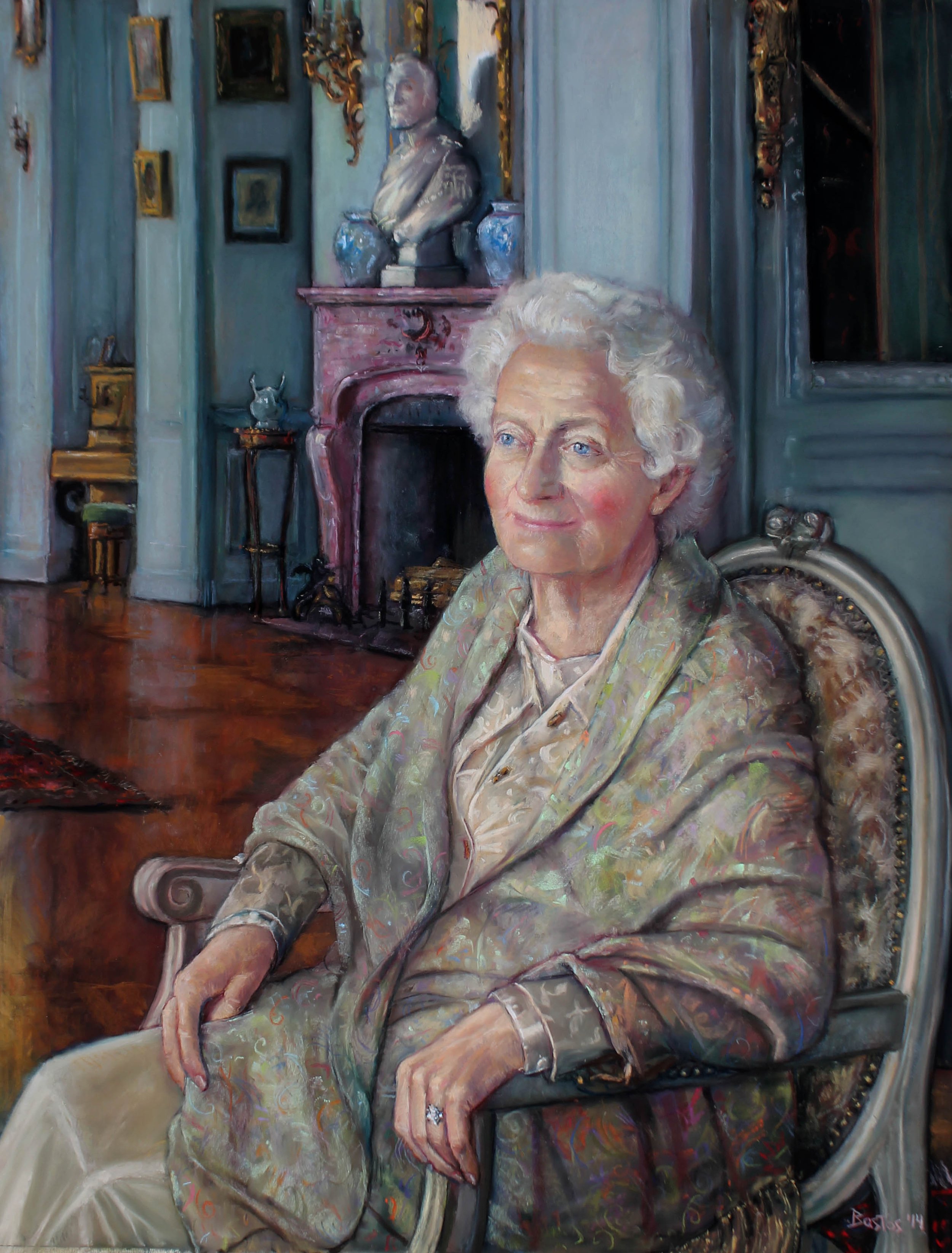
Baronne de Lassus
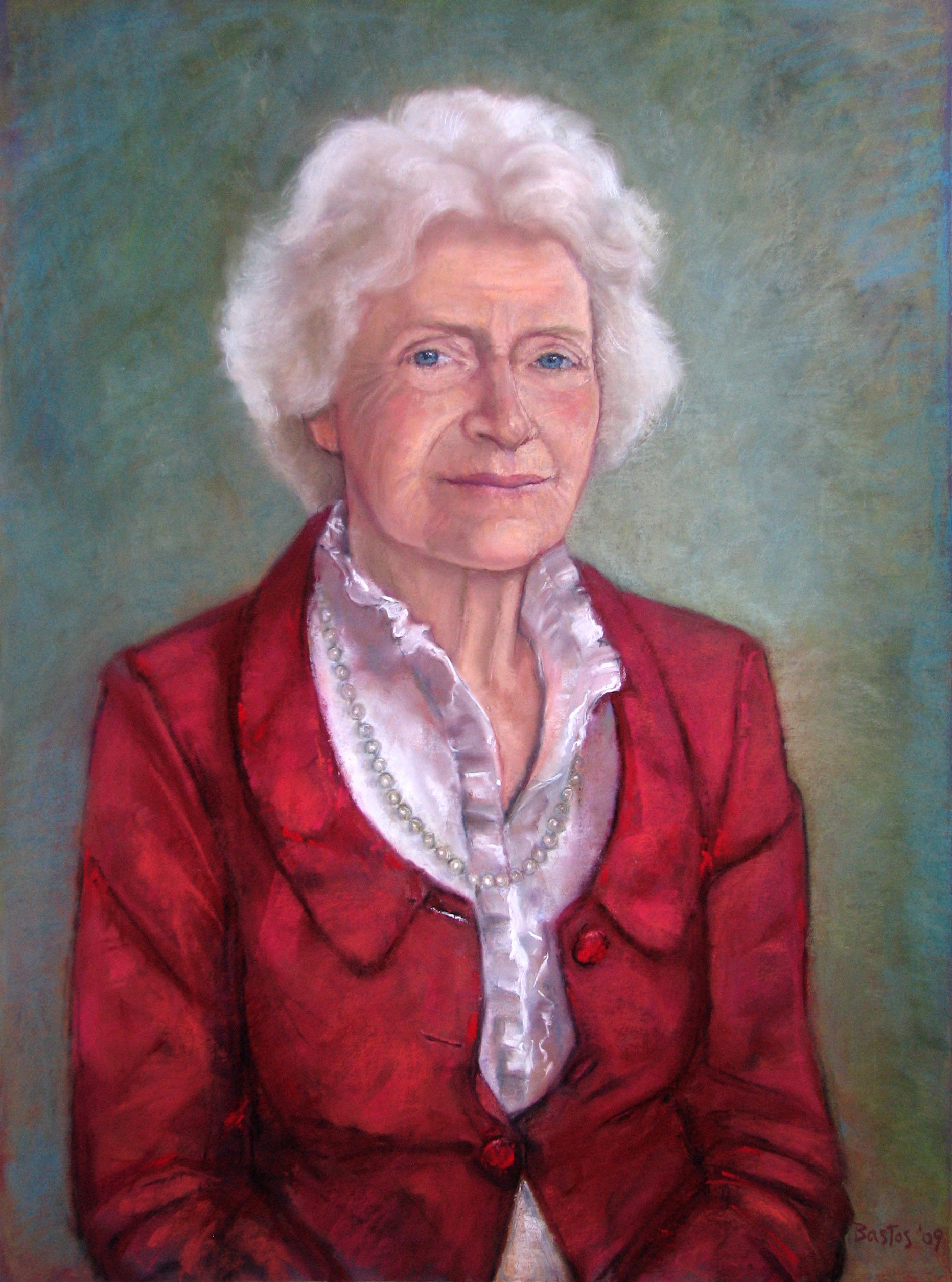
Baronne de Lassus
Q&A
Renowned Portrait Painter Juan F. Bastos: An EGW Exclusive Interview
Juan Bastos with his painting of Joyce Eisenberg-Keefer
Observing how well you particularly capture women in your portraits, tell us what is the root and inspiration to achieve what you get.
I had great female role models in my family. My grandmother on my mother’s side was the first woman in La Paz, Bolivia, who finished high school. At the time, most of the students got married before finishing their education. She managed the administration of her country houses and also had duties as a wife, who was married to a diplomat and politician. Later in life, after having been exiled to another country, she was an optimist, who kept studying, which culminated attending Georgetown University in her late 60s in order to polish the English that she started learning late in life. My grandmother on my father’s side had to bring up her three children on her own after being separated from her husband. She volunteered as a nurse during the Chaco War in Bolivia and wrote a cookbook when she was in her 70s. My mother continued the family tradition of strong women by founding, along with her classmates the Social Work Department at San Andres University in La Paz. Most women of her generation would just get married after finishing high school. She was the first person to bring the “Peabody Method” to children’s nurseries in La Paz, after having learned the skills working at a nursery in Bethesda, MD, while my father was working on an energy research project. Two aunts were professional artists who inspired me and taught me how to draw and paint while growing up. Finally, I had three older sisters, all very accomplished, who reminded me to have good manners, gave me English lessons, and many useful tips that I still use today when I meet a woman. My two nieces are also ambitious, having graduated from Smith College and Kings College, London.
You've worked with many accomplished and inspiring women, including Pamela Joyner, Patricia Morison, Janine Belmont, Valerie Sobel, and many others. What was it like to collaborate with such strong and accomplished women, and how did it inform your artistic process?
Pamela Joyner is the most important art collector of African American Art, and her collection is on display in her San Francisco home. Pamela, a Harvard MBA, is a visionary. She possesses amazing will power, wit and a passion for fashion, particularly high couture in addition to her extensive art collecting. When we were trying to decide what she was going to wear in the portrait, she showed me her closet and we picked a pink Christian Dior dress from amongst the more than 200 gowns. The reason for such a large collection is that she’s on the board of many institutions and charities, and the paparazzi are constantly taking pictures of her. She has been called “The Diana Ross of the Art World.” She had a large abstract painting in pinks and oranges in her collection that the artist painted based on her aura. She liked my idea of posing with it as the background, and the result tells the story of a strong, beautiful woman, enveloped in color. During the sitting, I learned about our shared love of Classic movies, and her admiration for characters such Scarlett O’Hara and Mildred Pierce. She and her husband Fred Giuffrida are a formidable couple.
Janine Belmont if the Chairman of Yanbal, a multi-national, family-owned beauty products company based in Peru. I traveled to Lima to work on her portrait and other portraits of her family. Her older brother declined to work at the company, so her father, who had inherited the business from his father, a pharmacist, and had grown it into a multimillion-dollar business, put her in charge. Georgetown-educated Janine is the mother of very accomplished children while managing a successful company. Although she was very busy, she made time for me to sit for her portrait at a final live session. When I finished, I asked her to call me a taxi so I could go and have a late lunch where I was staying. Her driver had a lunch break, and she decided to take me, even though it was in the opposite direction of her destination. The portrait is in creams and has a bit of an art deco feeling. Her elegance, simplicity, and taste are reflected in the portrait.
Valerie Sobel is a survivor. The first time I met her was at a fashion show. She was in her 70s, and in my opinion, she eclipsed the young models on the runway. Valerie exudes a unique personality. No wonder she’s on the cover of an “Advanced Style” book by Ari Seth Cohen. Not only is she a social icon, but also runs the Andre Sobel River of Life Foundation. In memory of her son, who died of cancer. After escaping communism in Hungary at 17, she immigrated with them to America. Her life has been like a movie ever since.
Not all my portraits are commissions. Once in a while, I’m interested in painting someone that grabs my attention. This was the case with Valerie, who was very gracious and came to my studio bringing a few different outfits from which I could pick. We opted for the “Catherine the Great Look,” as I called it. Reflecting on her strong personality, I chose a direct, frontal pose with a stunning neckless, topped with a hat. I included her portrait in my “Juan Bastos: California Retrospective” solo exhibition at the Denenberg Gallery in West Hollywood, and Valerie arrived with Princess Michael of Kent, a good friend of hers.
You've also created portraits of famous figures like Charlize Theron and Susan Sontag. What was it like to work with them, and how did you approach capturing their likeness and personality in your art?
They were both done from photos, so unfortunately, I didn’t get a chance to meet them. At the time, Charlize had won an Oscar for “Monster.” I not only wanted to capture her beauty but also her depth as an actor. Susan Sontag died a few years before I did the portrait, so I chose to represent her middle age with that directness and intelligence that she possessed. The frontal choice adds to the mood of the portrait. Both portraits were done in pastels.
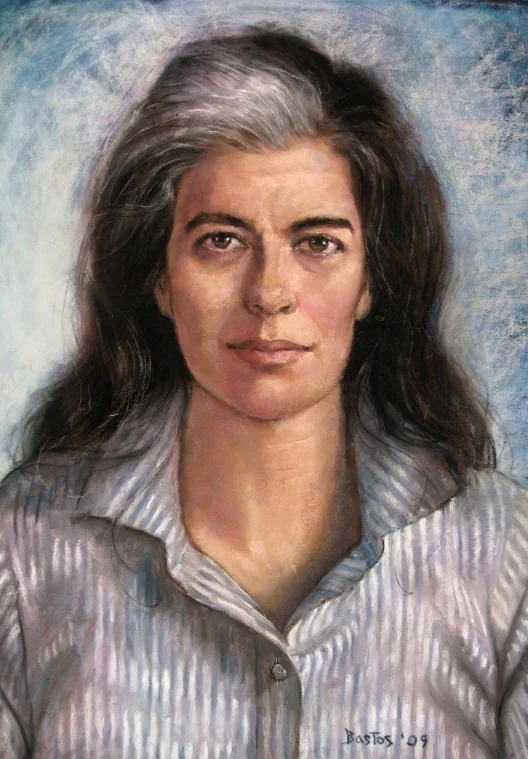
Sontag
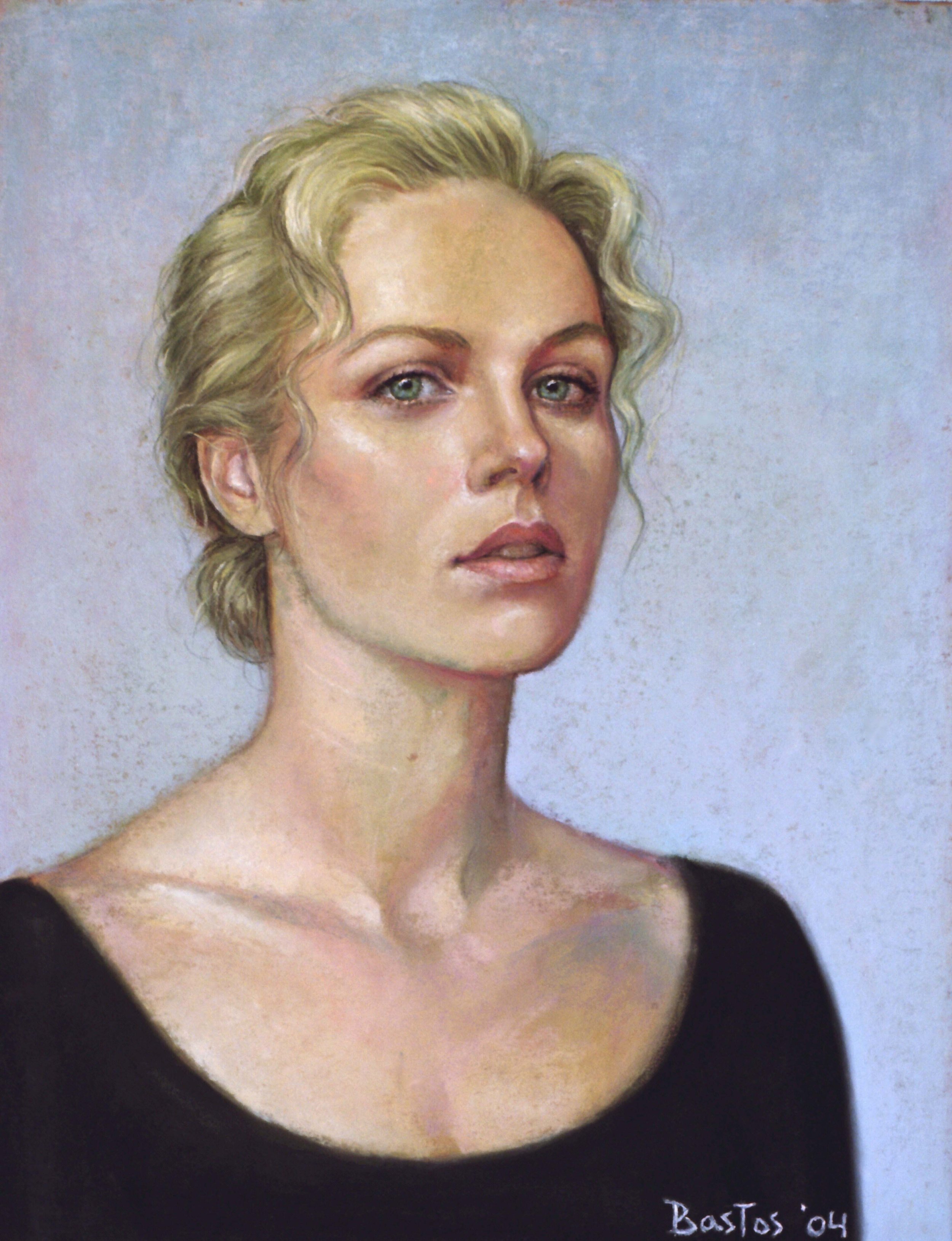
Chariize Theron
Many of your portraits are in pastel, while others are in oil or pencil. How do you choose the medium for each piece, and how does the medium influence the final result?
When I told my mother that I wanted to do her portrait, she said, “yes, as long as it’s a pastel.” Pastels are a softer medium, and my mother, already in her 60s, knew that the medium would be kind to her. Nevertheless, I try to give my pastels drama and strength, so many people mistake them for oils. Without color, a pencil drawing is more abstract, but the likeness and delicate lines immediately capture the essence of the subject.
Your portrait of Patricia Morison is incredibly striking and captures her vivacious personality perfectly. Can you tell us about your experience painting her and what it was like to work with such a legendary actress?
Patricia was in her late 80s when she came as a “plus-one” to a dinner party at our home. Her beauty and luminous presence enchanted me, and we became fast friends. Born in NY, she took dance classes with Martha Graham and won a scholarship to study art in Paris, but instead opted to be an actress. Once in Hollywood, she played the bad girl because she refused to dye her hair blond.
Fortunately, Cole Porter asked her to be Kate in his new musical “Kiss Me Kate” after hearing her sing. Fame and recognition soon followed. With Al Johnson and Dorothy Lamour, she entertained the troops by singing during World War II in England. She never married and supported her family with her career. Many years after meeting her, I asked if she could pose for me, and she replied, “Juan, but I am 99 years old.” I told her beauty transcended her age.
All the ingredients for a great portrait were there. The camera loved her. She had star quality. She was talented. All of this helped me to achieve a beautiful pastel. At the age of 102, she came to my California Retrospective to pose with her portrait for the press.
You painted a portrait of Thanpuying Lursakdi Sampatisiri and her husband in Bangkok, Thailand. Can you tell us more about the experience of working with them and how the cultural context influenced your artwork?
Both portraits were done posthumously, so the stories of their life, taste, and legacy came from her daughter, who commissioned the works. Thanpuying Lursakdi Sampatisiri was the sole heiress of her family’s fortune when she was in her 20’s, and created an empire in the hotel business. She also rose in the Thai government to become Minister of Transportation, the first female in the cabinet. Her daughter, Pag Bodiratnangkura, took over the company from her mother. She also commissioned a portrait of her four grown children.
The Bodirat clan consists of three daughters and one son: Pat, a jewelry designer, based in London and Bangkok; Lek, now the CEO of the Nai Lert Group, the family company and one of the oldest in Thailand; Dang, a real estate developer in Los Angeles; and Tat, the son, a London antique dealer.
Visiting Bangkok was an unforgettable experience. The apple doesn’t fall far from the tree, and all the women in the family are hardworking, ambitious and glamorous. They look like they are about to walk a red carpet every day!
Can you tell us about your approach to capturing multiple personalities in a single work of art?
In my portrait of Pat, Lek, Tat and Dang from Thailand, the siblings are posing with a moody Asian landscape mural in the background. My choice to have the three sisters sitting on the red couch, was to give each one her own space, glowing with their unique personality and beauty. I believe that all of them are equals, and as the eye wonders across the composition, they all grab your attention. The brother stands to the side, giving the sisters prominence.
Your pencil drawing of Julie Newmar is stunning and perfectly captures her beauty and grace. Can you tell us about your experience working with her and what inspired you about her as a subject?
In 1996, I met the former Catwoman from the ‘60s Batman TV series. With an IQ of 135, this beautiful, sensual actress is a muse for any artist. When I told her I wanted to do a pencil drawing of her, she prepared for the sitting by taking charge of every detail of her make-up, hair, and dress. A perfectionist with an amazing eye, she already knew the best light where she should sit. No pictures were taken. It was all done from life. She sat quietly, and I swam into those cat eyes while I drew, telling her how much I admired her for her film, theater, and television career. In the drawing, you see her powerful glance and eternal beauty.
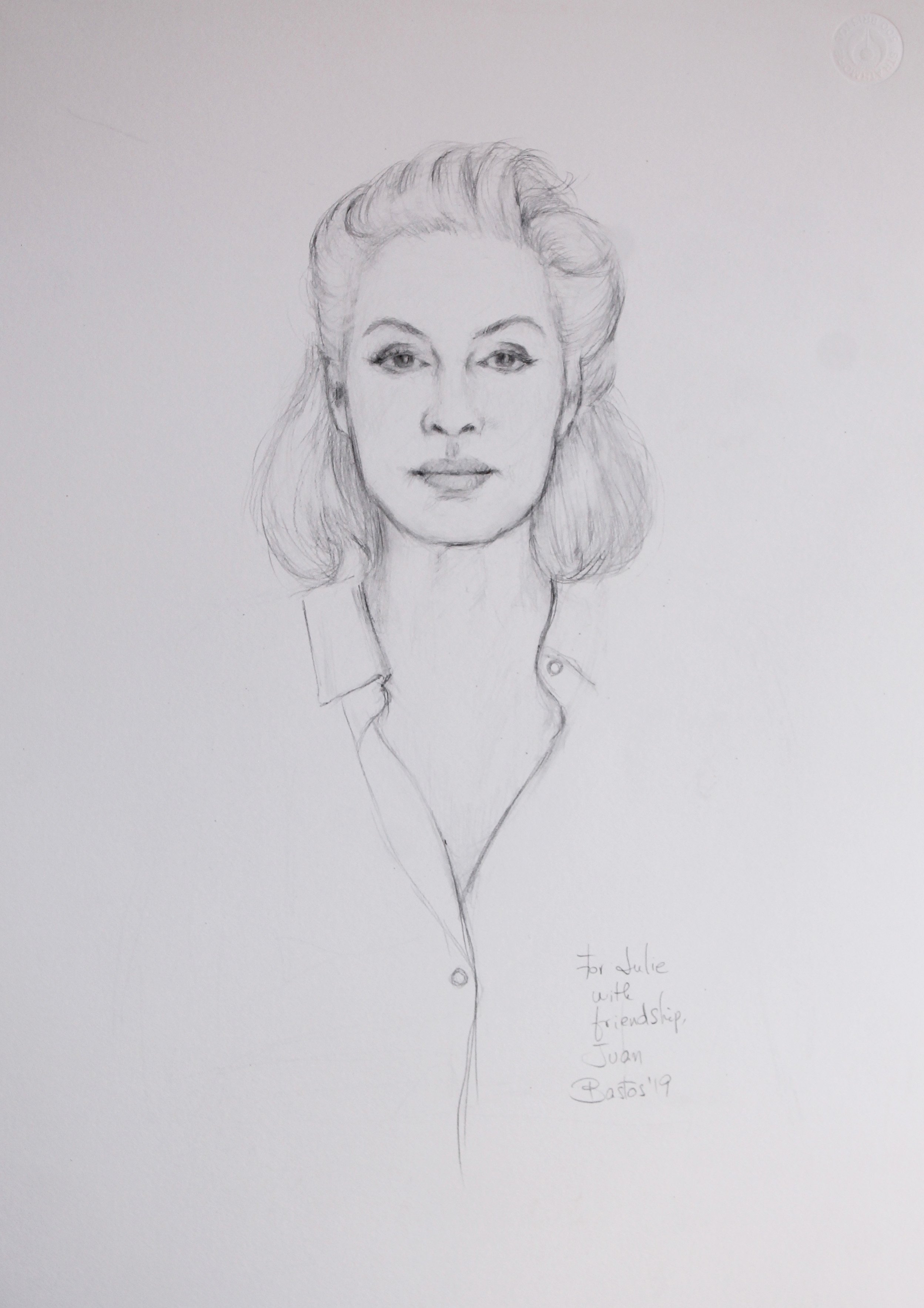
Julie Newmar drawing by Juan Bastos
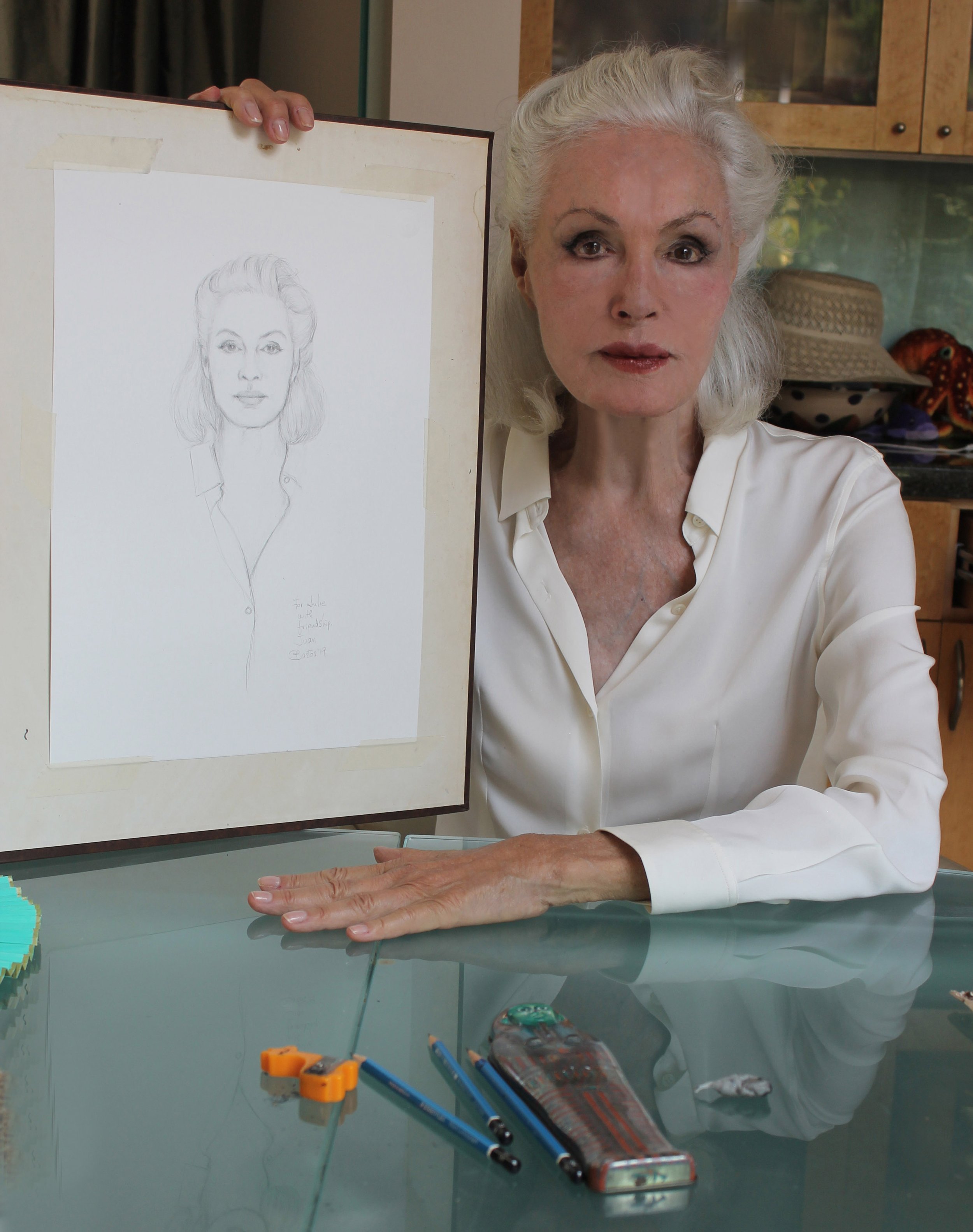
Julie Newmar
You recently created a portrait of Dr. Marisa Porges for The Baldwin School in Pennsylvania. Can you tell us more about the process of creating that portrait and what it was like to collaborate with such an accomplished academic and leader?
I was a bit overwhelmed before meeting Marisa, an extremely accomplished woman. A Harvard graduate, with degrees from the London School of Economics and King’s College, she served a U.S. Navy pilot in an air wing of two hundred, worked in the Obama White House, and published a recent book entitled, “What Girls Need: How to Raise Bold, Courageous, and Resilient Women.” When I met her at the school, I was approached by a young woman with a great sense of fashion, who asked me not to stand on formalities. “Call me Marisa,” she said. I then told her, “It’s too bad I’m not doing a full-length portrait; I love your shoes!” We both laughed, breaking the ice. Having a portrait done was part of what the school required, and I had to guide her through the process and my vision. I was thrilled that she chose an elegant dark blue dress for the sitting, and wanted me to include her dog Disco in the portrait. Institutional portraits sometimes are impersonal and generic. In my portrait, she is depicted as an approachable Head of School, with Baldwin in the background, accompanied by her dog, a symbol of loyalty and love. I included the American flag as a reminder of her time serving in the Navy. I got to know her better on my second trip, where we had a second sitting for the painting. She really liked the final result.
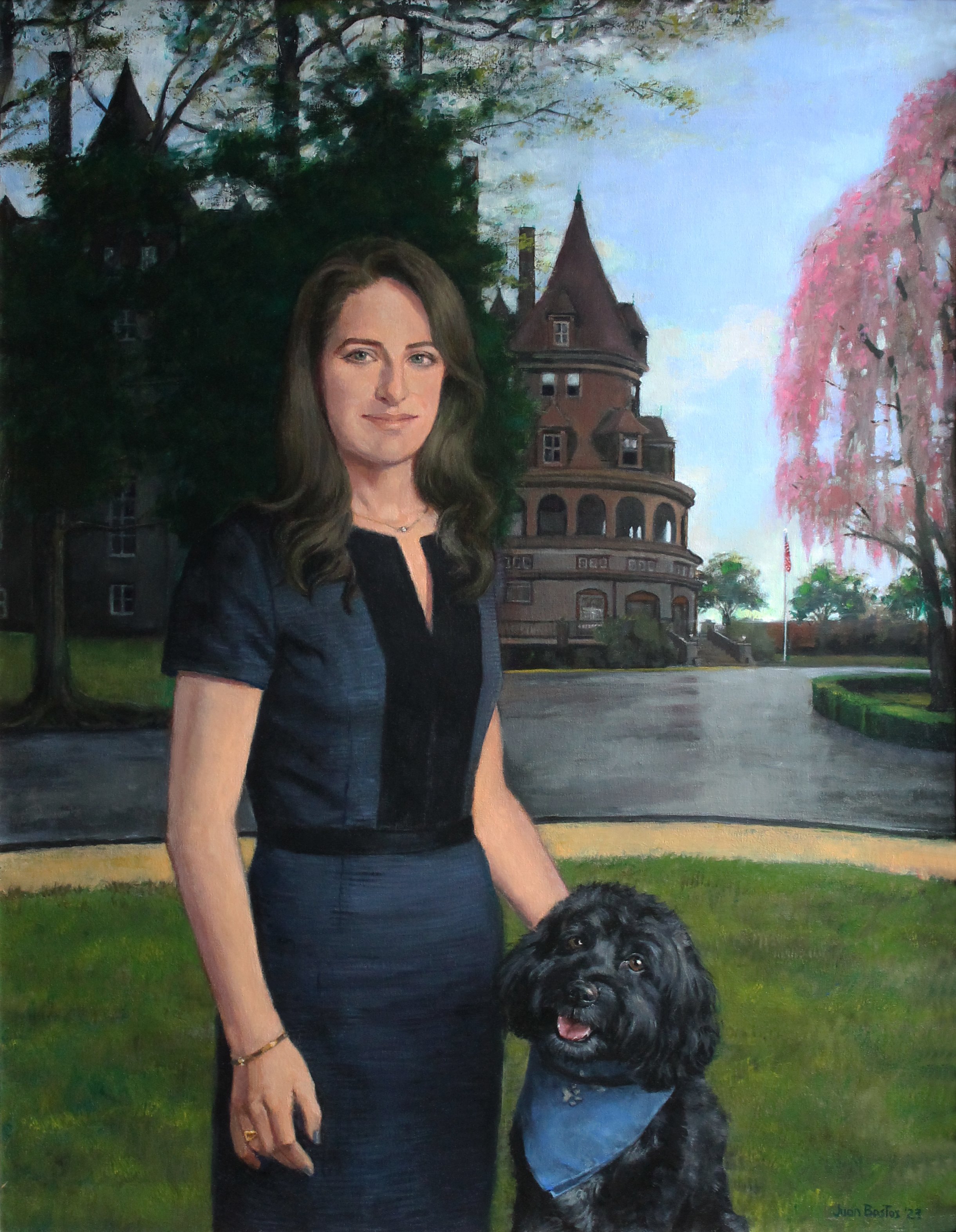
Dr. Marisa Porges
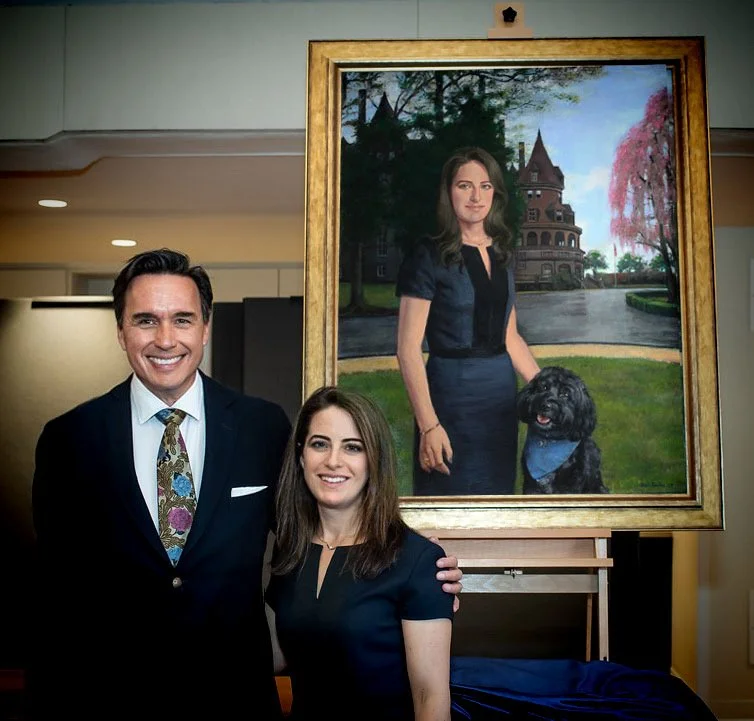
Juan with Dr. Marisa Porges
Finally, what have you learned about women and femininity through your work as an artist, and how has it influenced your personal life and relationships?
I can relate to the challenges women face while aging while keeping themselves attractive. It’s the same in the gay community, where men, in particular, face a similar experience. We all want to look our best. First impressions are important, so I prefer to be overdressed rather than underdressed. Los Angeles can be very casual, but I enjoy maintaining my own sense of individuality. The first impression when one meets a possible client or at a party is to project elegance and confidence. I find it healthy to have a certain amount of vanity.
Lursakdi Sampatisiri
One of the most captivating portraits created by the esteemed artist Juan F. Bastos is the stunning depiction of Thanpuying Lursakdi Sampatisiri. This portrait stands as a powerful tribute to an extraordinary woman whose legacy and accomplishments continue to inspire.
Commissioned posthumously, the portrait of Thanpuying Lursakdi Sampatisiri tells the story of a remarkable life and her enduring impact on society. Thanpuying Lursakdi, a visionary businesswoman and politician, inherited her family's fortune and built an empire in the hotel industry. She also held the esteemed position of Minister of Transportation, becoming the first female member of the Thai cabinet.
In the hands of Juan F. Bastos, the portrait comes alive with an air of elegance, grace, and sophistication. The artist's meticulous attention to detail is evident in every stroke of the brush, capturing not only the physical likeness of Thanpuying Lursakdi but also the depth of her character and the strength that defined her.
The composition of the portrait is carefully crafted, incorporating elements that pay homage to her extraordinary life. The backdrop of the portrait features her family home, built by her father and now a museum, symbolizing her connection to her homeland and the beauty that surrounded her. It creates a harmonious balance between the subject and her environment, reflecting the way Thanpuying Lursakdi seamlessly merged her personal and professional spheres.
Through the artistry of Juan F. Bastos, we are invited to delve deeper into the life and accomplishments of Thanpuying Lursakdi Sampatisiri. The portrait serves as a timeless reminder of her contributions and the lasting impact she had on her family, her community, and Thailand's business and political landscape.
With every brushstroke, Juan F. Bastos honors the legacy of extraordinary women, capturing their essence and preserving their stories for generations to come. The Lursakdi Sampatisiri portrait stands as a testament to the power of art in immortalizing the remarkable individuals who have shaped our world.


